The astronauts who put the USA on the moon
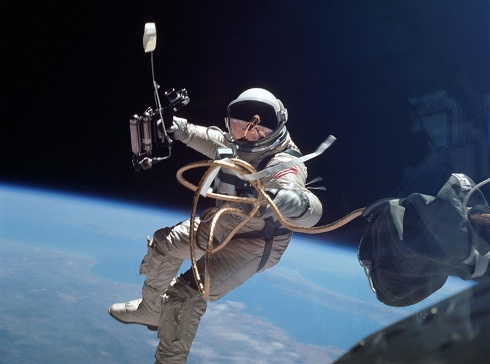
The Soviet Union launched Sputnik 1 into an elliptical low Earth orbit on October 4, 1957. This surprise precipitated the space age and triggered the space race. The success ushered in new technological, political, military, and scientific developments.
On April 12, 1961, Yuri Gagarin became the first person in history to leave the Earth’s atmosphere and venture into space. His flight aboard a Soviet Vostok rocket lasted 108 minutes, at the end of it he had ignited the manned space race.
Who were men who responded to these Soviet firsts, launching America into space and then onto the moon?
NASA selected the first US astronauts, the Original Seven (also referred to as the Mercury Seven and Astronaut Group 1), on April 9, 1959. This was the only astronaut group with members who flew on all classes of NASA manned orbital spacecraft of the 20th century — Mercury, Gemini, Apollo, and the Space Shuttle.
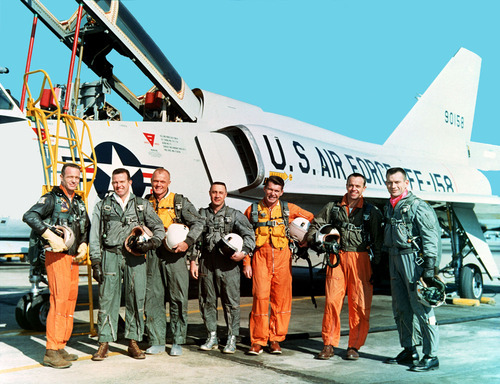
The original seven were Alan B Shepard Jr, Virgil I “Gus” Grissom, John Herschel Glenn Jr, M Scott Carpenter, Walter M “Wally” Schirra, Leroy Gordon Cooper Jr, and Donald K “Deke” Slayton.
The first American launched into space was Alan Shepard, followed by Gus Grissom. Their ballistic flights were followed by orbital flights by John Glenn then Scott Carpenter, each managing three orbits. Wally Schirra made six orbits and Gordon Cooper completed the Mercury project with 22 orbits. Cooper was the first American travelling in space for over a day and the last American to be launched solo into Earth orbit. Deke Slayton, was grounded in 1962 due to a heart arrhythmia, but reinstated in 1972 and flew on the Apollo-Soyuz Test Project in 1975.
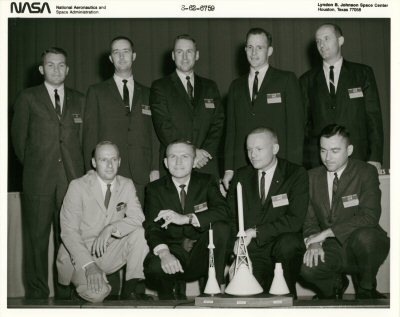
With the announcement of the Gemini program and planning of the Apollo program a second group of astronauts were selected by NASA and announced on September 17, 1962. The New Nine augmented the original Mercury 7. While the original seven had been selected to accomplish the simpler task of orbital flight, the new challenges of rendezvous and lunar landing led to the selection of candidates with advanced engineering degrees (for four of the New Nine) as well as test pilot experience.
This illustrious group became the first group with civilian test pilots in the group; Neil A Armstrong, first man on the moon and Elliott M See Jr, killed in a plane crash four months before he was due to pilot Gemini 9. Two of this group, Charles Conrad Jr and James A Lovell Jr, had been candidates for the original seven, but were not selected then for medical reasons. In addition, the group was Frank F Borman Jr, James A McDivitt, Thomas P Stafford, Edward H White II, and John W Young.
NASA announced the third group of astronauts, the “Apollo fourteen” in October 1963. Four (Charles A Bassett II, Roger B Chaffee, Theodore C Freeman, and Clifton C Williams Jr) died in training accidents before they could fly in space. Chaffee was killed along with Grissom and White in the Apollo 1 fire. All of the surviving ten (Edwin E “Buzz” Aldrin Jr, William A Anders, Alan A Bean, Eugene A Cernan, Michael Collins, R Walter Cunningham, Donn F Eisele, Richard F Gordon Jr, Russell “Rusty” L Schwiekart, and David R Scott) flew in the Apollo program; five (Aldrin, Cernan, Collins, Gordon, and Scott) also flew Gemini missions. Aldrin, Bean, Cernan and Scott walked on the Moon.
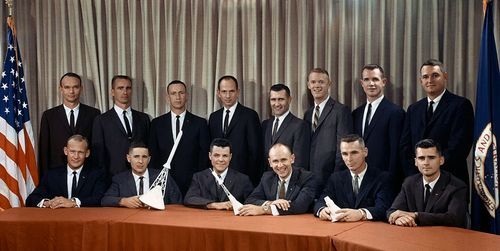
Group 3 was the first group to include candidates with no test pilot background. They are the only ones of the first 19 NASA astronaut groups to have no members at all fly on the Space Shuttle.
The fourth group of astronauts, the Scientists, selected by NASA in June 1965, came as a rude shock to the existing astronauts. While the astronauts of the previous three groups were required to have college and some advanced degrees, they were chosen for their test pilot expertise. The six members of this group, on the other hand, were chosen for their research and academic backgrounds. Doctorate degrees were required and minimum flight time requirements were waived for this group.
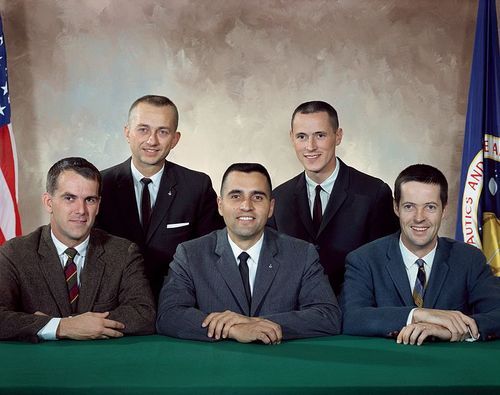
This group included the science poster boy, Harrison H Schmitt, a geologist, the only scientist to walk on the Moon. Owen K Garriott, Edward G Gibson and Joseph P Kerwin all flew to Skylab. Garriott also flew on the Space Shuttle. While Duane E Graveline and F Curtis Michel left NASA without flying in space.
John Young labelled the next astronaut group, selected by NASA in April 1966, the “Original Nineteen” in parody of the original seven Mercury astronauts. Of the six Lunar Module Pilots that walked on the Moon, three came from this group (Charles M Duke Jr, James B Irwin, and Edward D Mitchell). This group is also distinctive in being the only time when NASA hired a person into the astronaut corps who had already earned astronaut wings, X-15 pilot Joseph “Joe” H Engle.
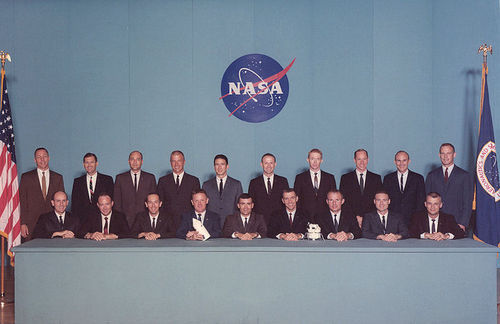
The group as a whole is roughly split between the half who flew Apollo (Duke, Ronald E Evans Jr, Fred W Haise Jr, Irwin, T Kenneth Mattingly II, Mitchell, Stuart A Roosa, John Swigert Jr, and Alfred M Worden) and the other half who flew Skylab and Shuttle (Vance D Brand, Gerald P Carr, Engle, Don L Lind, Jack R Lousma, Bruce McCandless II, William R Pogue, and Paul J Weitz) providing the core of Shuttle Commanders early in that program. John S Bull resigned from the program for medical reasons, whilst Edward G Givens Jr died in a car crash after being support crew for Apollo 7.
The final group of this era, the second group of scientist-astronauts, were appointed by NASA on August 11, 1967. They were labelled the “excess Eleven” with only five, including the first Australian born astronaut Philip Chapman, given formal assignments in the Apollo Program, and these were all non-flying. These were: Joseph P Allen, Chapman, Anthony W England, Karl G Henize, and Robert A R Parker. Chapman resigned from NASA in July 1972 due to lack of space-flight opportunities. Three others, Donald L Holmquest, Anthony A Llewellyn, and Brian T O’Leary resigned earlier from the group for various reasons.
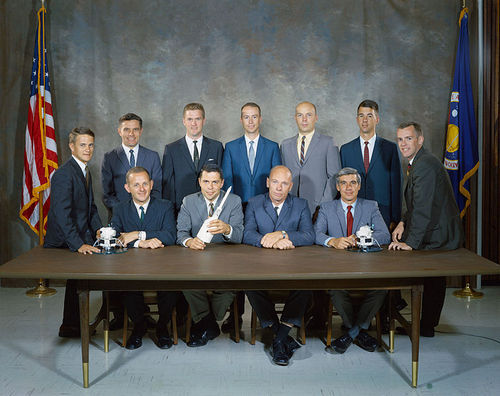
Assignments for the group were delayed by the requirement to spend a full year to become qualified as jet pilots (as were the Group 4 scientists before them). This requirement for scientists to be trained as jet pilots was eventually lifted with the creation of the Mission Specialist position in the Shuttle Program. The seven members (Allan, England, Henize, William “Bill” Lenoir, Story Musgrave, Parker, and William E Thornton) of Group 6 who stayed with the program after Apollo went on to form the core of Shuttle Mission Specialists, accomplishing a total of 15 flights.
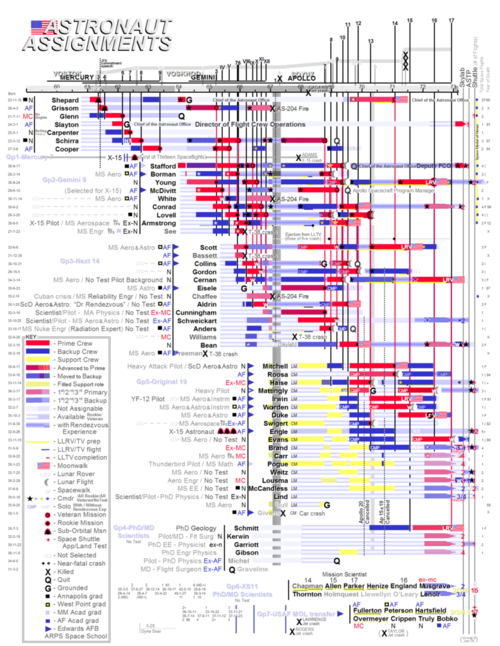
In all 66 men became NASA astronauts during this first era of manned space exploration. No women were included – although there was an unofficial group called the First Lady Astronaut Trainees– not being jet test pilots there were ineligible to become astronauts.
Was this a “boys’ own adventure”? Was this a period of great social upheaval in the USA? Did this era cement in the US politicians and public the image of supremacy and isolationism in space endeavors? Yes, is the answer to all three questions.
There are a myriad of stories from these groups’ exploits. These stories have a contemporary relevance as we reach an era of: new commercial space opportunities (leisure, exploration and mining), new entrants (China and India), and find the US and Europe hampered by self-imposed budget challenges and hurdles.
Orrman-Rossiter K (2012-10-31 00:19:52). The astronauts who put the USA on the moon. Australian Science. Retrieved: Nov 12, 2025, from https://ozscience.com/history/the-astronauts-who-put-the-usa-on-the-moon/
 Follow
Follow